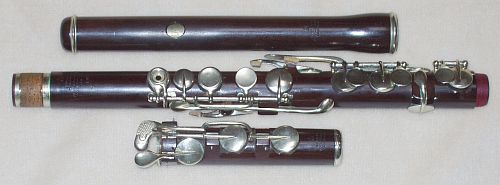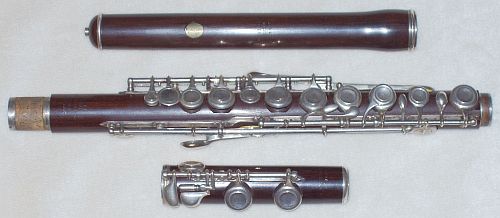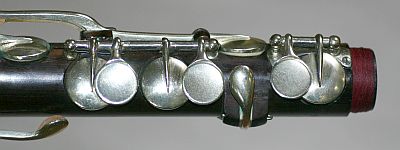

English players, in the mid or late-nineteenth century, who wanted the sound and easier intonation of a Boehm flute but who would not consider learning the new fingering system required, could always opt for a "modern flute" with the "old system" of fingering. Richard Carte designed such a flute in 1851, and it and variations on it were always part of the offerings of the firm of Rudall, Carte & Co.
Shown below is a "model k1" from Rudall Carte & Co., made in 1883. It is similar to the "model d1" Old System flute described on the Hybrid System page, but is somewhat old fashioned in having keys mounted in wooden blocks rather than on posts, and it has the old form of the foot joint keys, without axles.

Robert Sidney Pratten (1824–1868) proposed many designs for improved flutes from c.1855 on, most called "Pratten's Perfected". At first, these were large-holed simple system flutes, but the name was used later for cylindrical flutes with large holes and ring keys or other devices.
The flute below is by Boosey & Co. flute, circa 1906. It appears to match an instrument (model A174) depicted in a Boosey catalog of c.1900 of a "Pratten Cylinder" flute. It is one of the more highly mechanized Pratten models.

Both of these flutes have cylindrical bores with tapered head joints and large holes. Both have the eight keys of the standard English simple system flute: closed D# and open C and C# on the foot; closed keys for C, Bb, G#, and long and short F keys, on the body. The long F and G# keys are seen below.


The six holes sounding the notes of the D major scale are, on these flutes, controlled by open standing keys. The large. mostly equal-sized holes are put in something close to their correct accoustical positions, and the mechanism allows the fingers to reach and cover the holes. One can see below, on the top of the Rudall Carte instrument, the covered holes for G, F#, and E as well as the touches for the three right hand fingers. (These holes had to be more-or-less equally spaced and closer to one another on one-key and simple system flutes, with the E hole smaller than the other two.) There are two holes for F on the sides of the flute.

These flutes have an extra smaller hole or two to help adjust the C's and C#'s (more about that below). And the Boosey has a D/C# trill key.
These flutes are not "fully vented". For example, when playing A in the first or second octave, the G# hole remains closed, as it is on a simple system flute. The A hole is placed so that the A is in tune with the G# key closed. Some might hear a slight difference in quality between this A and the G, say, where the F# hole is open. But it is very slight and easily disguised.
Players of the simple system flute would have been sad to learn that the fingerings in the third octave do not match the old flute. Perhaps purchasers of this type of flute did not do much third octave playing. anyway. But the flutes do work fine up there with the proper fingerings. The e''' is fingered 12-45-k, as on the Boehm flute—and is properly vented, with only the A hole open. And the F# fingered 1-34--k is also properly vented, with only the B hole open! This is an easy and beautiful note on the Boosey. But not on the Rudall, Carte, because the B hole seems to be in the wrong position—it is higher and smaller than on the Boosey—and I am sure that 1-34--k was not the recommended fingering. The reason the B hole is not right has to do, I presume, with this model's method of producing C and C#.
On both these instruments, an extra hole or two and extra mechanism is used to get both c'' and c''' in tune with the old fingering -2-456k. The extra mechanism is similar to the brille used on some German and English flutes. The Boosey, with two extra holes, seems slightly more successful to me; but on both flutes the c'' is still a badly veiled note. This (and the slight tonal uneveness mentioned above) is what Rudall, Carte are presumably refering to when they say of their "Old System" flute that "As it is impossible when this fingering is retained, to put all the holes in their absoutely correct positions, some traces of the inherent defects of the Old Flute are still to be found in it".
